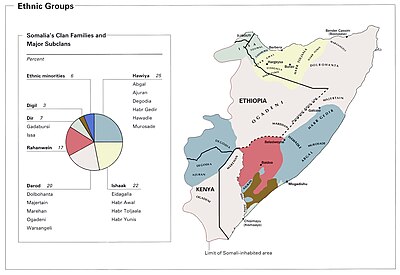This is an old revision of this page, as edited by Gailtb (talk | contribs) at 18:15, 19 May 2006 (add map). The present address (URL) is a permanent link to this revision, which may differ significantly from the current revision.
Revision as of 18:15, 19 May 2006 by Gailtb (talk | contribs) (add map)(diff) ← Previous revision | Latest revision (diff) | Newer revision → (diff)
Somali clan refers to the clan grouping of the Somali people. It is an important social unit and clan membership continues to play an important part in their culture and in the politics of Somalia. The clan is patrilineal, ie traced through the male line. Clans are often divided into sub-clans, sometimes with many sub-divisions.
In traditional Somali society, marriage was often to someone from another clan, ie exogamy, but during the recent conflict in Somalia this seems to have become the exception rather than the rule.
Heirarchy of clans
Certain clans are classed as noble clans, referring to the belief that they share a common Somali ancestry, whereas the minority clans are believed to have mixed parentage. The four noble clans, known collectively as the Samale (or Samaale), are:
Sab is the term used to refer to minority clans.
The Rahanweyn (made up of the Digil and Mirifle clans) are an agro-pastoral group in the area between the Jubba and Shabeelle Rivers. They occupy a kind of second tier in the Somali social system - because they do not follow a nomadic lifestyle, live further south and speak a group of Somali dialects (Maay) which have recently been classified as a separate language, they have to some extent been isolated from the mainstream of Somali society.
A group of occupational clans have sometimes been considered as outcastes because traditionally they could only marry among themselves and other Somalis considered them to be ritually unclean. They lived in their own settlements among the nomadic populations in the north and performed specialized occupations such as metalworking, tanning and hunting. These clans include the Tomal, Midgan, Yibir, Ayle, Jaji and Yahar.